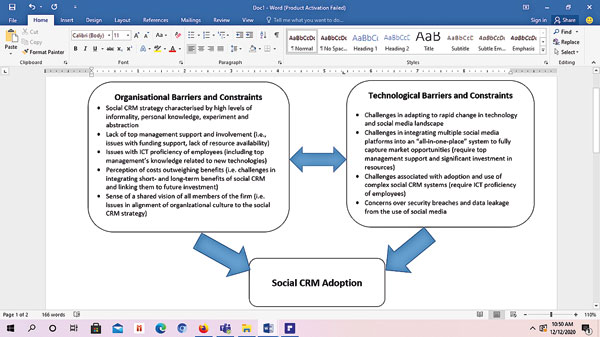Social customer relationship management goes mainstream: Critical factors underpinning its adoption

In this contemporary business landscape, organisations witnessed the significance of meeting customer needs as the epitome of the notion of marketing. Thus, the emphasis on marketing has moved from a transaction orientation compelled by the exchange paradigm to a relationship orientation grounded in the relational paradigm. Because of this evolving trend, research in marketing has focused on building and maintaining relationships with customers for some time. Customer relationship management (CRM) became a vital part of this research with the advent of new technologies supporting this customer relationship building and maintaining process.
The rapid emergence and adoption of social media have transformed the way organisations engage with their customers. In this new 2.0 environment, traditional CRM strategies have morphed into social CRM, providing mutually beneficial value for firms and their customers in a trusted and transparent business environment. Social CRM is more than simply an extension of traditional CRM, as it recognises the pivotal role of value co-creation aimed at facilitating the collaborative communications and relationships within a wider customer ecosystem involving multiple stakeholders (i.e., business partners, customers, suppliers, and customer communities) who continuously cooperate and integrate resources for co-creating value.

Prof. Athula Gnanpala
Despite the benefits that social CRM offers, surprisingly, most firms are still at the nascent stage of its adoption. To exploit the true potential of social CRM, firms need to be aware of the factors that drive social CRM adoption. However, the existing literature on social CRM focuses primarily on the characteristics, opportunities, and benefits that social CRM offer, but offer little insight into those factors that influence its adoption. This void is somewhat surprising given the importance of social media applications in creating meaningful conversations and high-value relationships between an organisation and its customers. To address this critical knowledge gap, we explored those factors that stimulate and shape the adoption of social CRM by applying qualitative research methodology.
We conducted semi-structured interviews with 12 senior managers of 12 tourist hotels who had a conclusive knowledge of the hotel’s CRM and social media initiatives. The hotel industry in Sri Lanka was selected as the research setting as CRM has become a widely discussed topic within the hotel industry in recent years. In Sri Lanka, the tourism and hospitality industry constitutes a major economic driving force. According to the Sri Lanka Tourism Development Authority, tourism surged to a new high record of 1.9 million tourist arrivals in 2019. Growth in competition among hotels has highlighted the importance of using CRM as a tool to enhance customer engagement and loyalty. Twelve tourist hotels were selected representing different scales of operations (denoted by the star rating category of the hotel), different durations of CRM system usage (from less than two years to more than ten years), and different average times allocated to social media usage per week, to ensure representativeness of our sample and improve the transferability and trustworthiness of the findings. All the selected hotels were actively used traditional CRM systems at the time of data collection and were active on social media. However, we were unable to identify hotels that adopted a complete social CRM solution.
Our findings show that social CRM adoption among hotels in Sri Lanka is at an early stage of adoption, characterised by trial-and-error experimentation and focusing on the technical aspects of adoption. Our analysis and synthesis of the findings contributed to developing an inductive descriptive framework of factors influencing social CRM adoption (see Figure 1). Draws on the views and perceptions of those senior managers involved in social CRM adoption within each hotel, this framework identified nine themes influencing social CRM adoption: perceived benefits, ICT proficiency of employees, funding and management support, time and resource availability, social CRM strategy, social CRM technology, integration with existing CRM, complexity, and privacy and security concerns.

Prof. Nicholas J. Ashill
Using this framework, we identify and discover interplays between the nine themes that have influenced social CRM adoption in the studied hotels. As depicted in the framework, the role of senior management, such as their ICT proficiency and understanding of contemporary technological and social trends, as well as their visible support and commitment, are vital in allocating resources (e.g., ICT infrastructure, financial and skilled human resources) and managing organisational changes required for social CRM adoption. For example, in five hotels, top management exerted strong support in social CRM adoption by allocating time and required resources. In three hotels, the support extended by senior management helped to overcome employee resistance, facilitate cross-functional learning, encourage employee involvement and create a shared vision to ensure the benefits generated from social CRM engagement were reaped.
Besides, in many hotels, financial costs impeded the hotel’s decision to adopt social CRM. Since adopting social CRM makes hotels highly visible to the public, a hotel’s reputation can be tarnished if executed poorly. Given that perceived costs were typically higher than perceived gains, most hotels preferred simple social CRM initiatives rather than an advanced social CRM system until a business case could be made. However, it was evident in two up-scale hotels whose senior management with a high level of ICT proficiency could foresee the financial value of social CRM adoption. As such, they could identify and invest in the most appropriate social CRM technologies at the right time, thus in the process of reaping the benefits of social CRM shortly.

Dr. Thilini Gamage
Our findings advance existing literature on CRM by demonstrating that successful social CRM adoption is a dynamic capability. We highlight that successful social CRM adoption requires firms to possess distinctive managerial (i.e., top management’s support and commitment in allocating resources and creating a shared vision among employees) and operational (i.e., ensuring social CRM strategy is entrenched in organisational practices and everyday routines) capabilities. Firms must design and formulate a social CRM strategy that most efficiently exploits these two capabilities; by doing so, they will effectively use firm resources and capabilities to enhance performance.
In addition to distinctive managerial and operational capabilities, developing a shared vision among employees is also critical in cross-functional knowledge sharing and integration within and across the firms. Since social CRM is not merely confined to technical specifications, it is observed that successful social CRM adoption requires change management initiatives to aligning organisational values and culture with the social CRM strategy. Thus, different from conventional technology adoption literature that falls short of holistically capturing a broad spectrum of adoption determinants, we highlight the need for a strategic approach towards social CRM adoption. In doing so, we respond to calls for research to develop a holistic framework to illustrate how organisational and technological factors influence social CRM adoption.
Our findings offer valuable insights to industry practitioners. First, while firms perceive a correlation between the objectives of their social CRM adoption and the benefits they earn, the payoffs are likely to be fully evident in the long run, making the cost-benefit risk appear more extensive in the short run. Consequently, practitioners with a robust strategic intent concerning customers and a well-thought-out social CRM strategy with clearly defined goals will be able to benefit from this initiative ultimately.
Second, our results indicate that the degree to which an organisation adopts, invests in, and implements social CRM depends on the context in which it operates and the firm’s current resources and capabilities. While large-scale firms may be well-resourced, structural inertia may prevent them from completely embracing social CRM due to their inability to adapt and seize new opportunities provided by emerging social media platforms. While structural simplicity and simplified operations may allow small-scale firms to be more versatile and adaptable, resource constraints often hinder the effective integration of social media with existing CRM systems.
Third, there appears to be a lack of understanding among all sampled firms on how they can best implement social CRM to generate profits and retaining control over their market presence. Our findings show that top management’s visible support and commitment in managing organisational changes required for social CRM adoption is critical. This aids in overcoming employee resistance to adopting new technologies, facilitating cross-functional learning, and encouraging employee participation to reap social CRM engagement benefits.
Fourth, our findings inform practitioners that social CRM is not merely restricted to technological specifications but requires a supportive and collaborative workplace climate. Thus a well-thought-out strategic approach to social CRM adoption is imperative. Since firms usually do not alter their current business practices but rather incorporate new social CRM support practices alongside their existing ones, it is important to build a social CRM strategy that best utilizes a firm’s managerial and operational capabilities to achieve a competitive advantage.
(This article is an extract of the research paper - Thilini Chathurika Gamage, Athula Gnanapala & Nicholas J. Ashill (2021) Understanding social customer relationship management adoption: qualitative insights, Journal of Strategic Marketing, DOI:10.1080/0965254X.2021.1923056 – Please refer to the original research paper for the detailed version)



